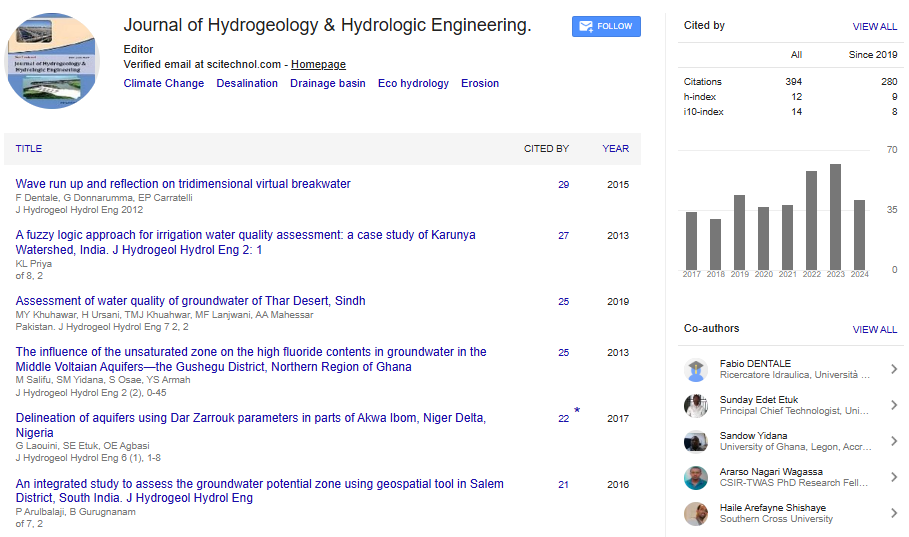Commentary, J Hydrogeol Hydrol Eng Vol: 13 Issue: 6
The Relationship of Water and Weather: The Science of Hydrometeorology
Claudia Rivera*
1Department of Hydraulic Engineering, Technical University of Denmark, Kongens Lyngby, Denmark
*Corresponding Author: Claudia Rivera,
Department of Hydraulic Engineering,
Technical University of Denmark, Kongens Lyngby, Denmark
E-mail: riverac68@gmail.com
Received date: 26 November, 2024, Manuscript No. JHHE-24-154125;
Editor assigned date: 28 November, 2024, PreQC No. JHHE-24-154125 (PQ);
Reviewed date: 12 December, 2024, QC No. JHHE-24-154125;
Revised date: 20 December, 2024, Manuscript No. JHHE-24-154125 (R);
Published date: 27 December, 2024, DOI: 10.4172/2325-9647.1000355.
Citation: Rivera C (2024) The Relationship of Water and Weather: The Science of Hydrometeorology. J Hydrogeol Hydrol Eng 13:6.
Description
Hydrometeorology is an interdisciplinary science at the intersection of meteorology and hydrology, focusing on the complex relationships between atmospheric and terrestrial water systems. This field is vital for understanding the dynamic processes governing the Earth's water cycle and its impact on human activities and natural ecosystems. By delving into topics such as precipitation patterns, surface runoff and atmospheric moisture transport, hydrometeorology provides essential insights for weather prediction, water resource management and disaster preparedness.
At its core, hydrometeorology examines the interactions between atmospheric water processes (such as precipitation and evaporation) and hydrological components (like rivers, lakes and soil moisture). This multidisciplinary approach bridges gaps between short-term meteorological phenomena and long-term hydrological trends. For instance, while meteorology might focus on forecasting a rainstorm, hydrometeorology extends this understanding to predict potential flooding, soil saturation levels, or impacts on water reservoirs.
A primary focus in hydrometeorology is the formation, intensity and spatial distribution of precipitation. By studying factors like cloud dynamics, atmospheric pressure and temperature gradients, researchers can determine how precipitation affects regional water balances.
This process involves the combination of evaporation from water bodies and transpiration from plants. It plays an essential role in maintaining equilibrium within ecosystems and influences how much water returns to the atmosphere.
Understanding the way precipitation transitions to surface runoff and contributes to streamflow is a vital aspect of hydrometeorology. This knowledge helps predict the movement of water through catchments and informs strategies for flood modification.
Winds and weather systems often carry atmospheric moisture over vast distances, influencing regional precipitation patterns. By analyzing these transport mechanisms, hydrometeorologists can assess how changes in global climate impact localized water systems.
Applications of hydrometeorology
Hydrometeorology has far-reaching implications across various sectors:
Flood forecasting and management: Accurate hydrometeorological data is precarious for early flood warnings and designing effective flood control measures. Models that combine rainfall predictions with river discharge data can prevent catastrophic damage to communities.
Agriculture: Increasing reliance on precision farming, hydrometeorological insights help optimize irrigation scheduling and crop planning, ensuring efficient water use and improved yields.
Urban planning and infrastructure development: Cities face unique challenges with stormwater management and drainage systems. Hydrometeorology supports the design of strong infrastructure capable of handling extreme weather events like hurricanes and torrential downpours.
Climate change impact assessments: Shifting climatic patterns, such as altered monsoon cycles or prolonged droughts, are complexly linked to hydrometeorological dynamics. Long-term observations aid in creating strategies to adapt to these changes.
Despite its importance, hydrometeorology faces challenges such as data scarcity in remote areas, the complexity of modeling interconnected systems and the growing unpredictability of extreme weather events. However, advances in satellite technology, remote sensing and artificial intelligence are revolutionizing the field. Highresolution climate models and real-time data analytics are enabling more accurate predictions and effective decision-making.
As global populations grow and climate change accelerates, the relevance of hydrometeorology will only increase. Integrating this science with policy-making and public awareness campaigns will be essential for sustainable water management and disaster risk reduction. Furthermore, fostering international collaboration can ensure that knowledge and resources are shared across borders, creating a more resilient global community.
Hydrometeorology represents an essential convergence of atmospheric and terrestrial sciences. By deepening our understanding of how water and weather interact, this discipline not only advances scientific knowledge but also empowers society to tackle pressing environmental challenges.
 Spanish
Spanish  Chinese
Chinese  Russian
Russian  German
German  French
French  Japanese
Japanese  Portuguese
Portuguese  Hindi
Hindi 
